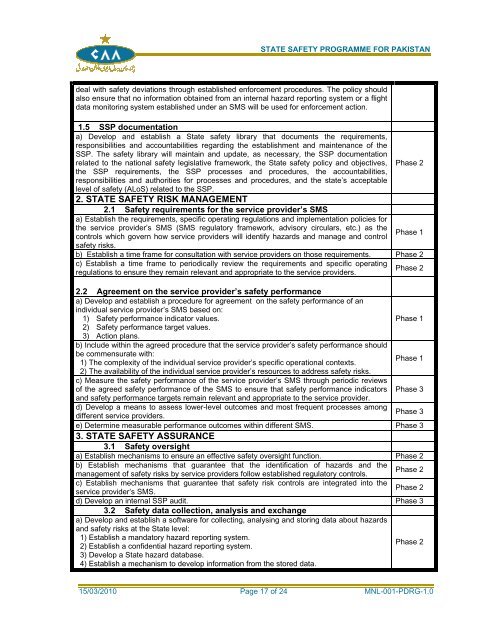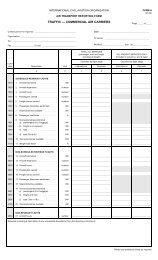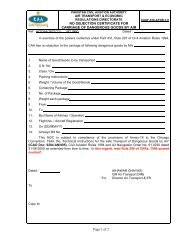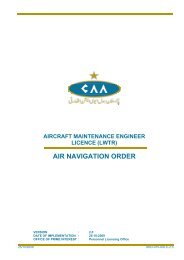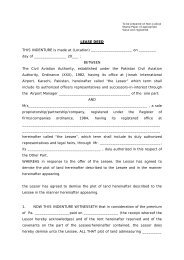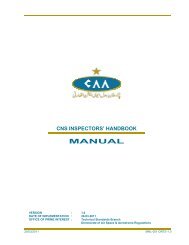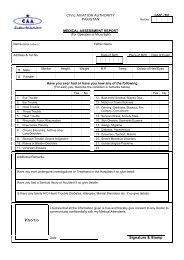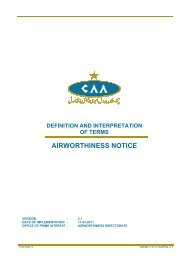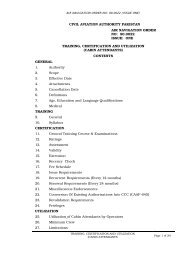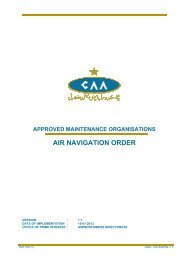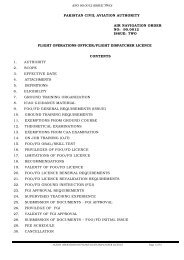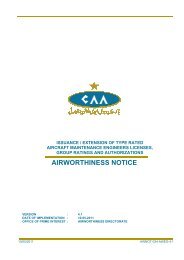state safety programme for pakistan manual - Civil Aviation Authority
state safety programme for pakistan manual - Civil Aviation Authority
state safety programme for pakistan manual - Civil Aviation Authority
Create successful ePaper yourself
Turn your PDF publications into a flip-book with our unique Google optimized e-Paper software.
STATE SAFETY PROGRAMME FOR PAKISTANdeal with <strong>safety</strong> deviations through established en<strong>for</strong>cement procedures. The policy shouldalso ensure that no in<strong>for</strong>mation obtained from an internal hazard reporting system or a flightdata monitoring system established under an SMS will be used <strong>for</strong> en<strong>for</strong>cement action.1.5 SSP documentationa) Develop and establish a State <strong>safety</strong> library that documents the requirements,responsibilities and accountabilities regarding the establishment and maintenance of theSSP. The <strong>safety</strong> library will maintain and update, as necessary, the SSP documentationrelated to the national <strong>safety</strong> legislative framework, the State <strong>safety</strong> policy and objectives, Phase 2the SSP requirements, the SSP processes and procedures, the accountabilities,responsibilities and authorities <strong>for</strong> processes and procedures, and the <strong>state</strong>’s acceptablelevel of <strong>safety</strong> (ALoS) related to the SSP.2. STATE SAFETY RISK MANAGEMENT2.1 Safety requirements <strong>for</strong> the service provider’s SMSa) Establish the requirements, specific operating regulations and implementation policies <strong>for</strong>the service provider’s SMS (SMS regulatory framework, advisory circulars, etc.) as thePhase 1controls which govern how service providers will identify hazards and manage and control<strong>safety</strong> risks.b) Establish a time frame <strong>for</strong> consultation with service providers on those requirements. Phase 2c) Establish a time frame to periodically review the requirements and specific operatingPhase 2regulations to ensure they remain relevant and appropriate to the service providers.2.2 Agreement on the service provider’s <strong>safety</strong> per<strong>for</strong>mancea) Develop and establish a procedure <strong>for</strong> agreement on the <strong>safety</strong> per<strong>for</strong>mance of anindividual service provider’s SMS based on:1) Safety per<strong>for</strong>mance indicator values.Phase 12) Safety per<strong>for</strong>mance target values.3) Action plans.b) Include within the agreed procedure that the service provider’s <strong>safety</strong> per<strong>for</strong>mance shouldbe commensurate with:Phase 11) The complexity of the individual service provider’s specific operational contexts.2) The availability of the individual service provider’s resources to address <strong>safety</strong> risks.c) Measure the <strong>safety</strong> per<strong>for</strong>mance of the service provider’s SMS through periodic reviewsof the agreed <strong>safety</strong> per<strong>for</strong>mance of the SMS to ensure that <strong>safety</strong> per<strong>for</strong>mance indicators Phase 3and <strong>safety</strong> per<strong>for</strong>mance targets remain relevant and appropriate to the service provider.d) Develop a means to assess lower-level outcomes and most frequent processes amongPhase 3different service providers.e) Determine measurable per<strong>for</strong>mance outcomes within different SMS. Phase 33. STATE SAFETY ASSURANCE3.1 Safety oversighta) Establish mechanisms to ensure an effective <strong>safety</strong> oversight function. Phase 2b) Establish mechanisms that guarantee that the identification of hazards and thePhase 2management of <strong>safety</strong> risks by service providers follow established regulatory controls.c) Establish mechanisms that guarantee that <strong>safety</strong> risk controls are integrated into thePhase 2service provider’s SMS.d) Develop an internal SSP audit. Phase 33.2 Safety data collection, analysis and exchangea) Develop and establish a software <strong>for</strong> collecting, analysing and storing data about hazardsand <strong>safety</strong> risks at the State level:1) Establish a mandatory hazard reporting system.2) Establish a confidential hazard reporting system.3) Develop a State hazard database.4) Establish a mechanism to develop in<strong>for</strong>mation from the stored data.Phase 215/03/2010 Page 17 of 24 MNL-001-PDRG-1.0


